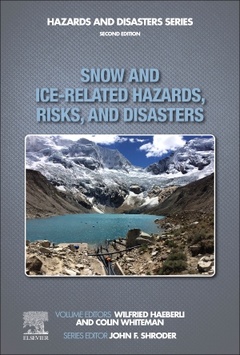Snow and Ice-Related Hazards, Risks, and Disasters (2nd Ed.)
Coordonnateurs : Haeberli Wilfried, Whiteman Colin
Rédacteur en Chef : Shroder John F.

1. Snow and Ice-Related Hazards, Risks, and Disasters: A General Framework 2. Physical, Thermal, and Mechanical Properties of Snow, Ice, and Permafrost 3. Snow and Ice in the Climate System 4. Snow and Ice in the Hydrosphere 5. Snow, Ice, and the Biosphere 6. Ice and Snow as Land-Forming Agents 7. Mountains, Lowlands, and Coasts: the Physiography of Cold Landscapes 8. Integrated Approaches to Adaptation and Disaster Risk Reduction in Dynamic Socio-cryospheric Systems 9. Integrative Risk Management: The Example of Snow Avalanches 10. Permafrost Degradation 11. Radioactive Waste Under Conditions of Future Ice Ages 12. Snow Avalanches 13. Glacier Surges 14. Glacier-Related Outburst Floods 15. Ice Loss and Slope Stability in High-Mountain Regions 16. Catastrophic Mass Flows in the Mountain Glacial Environment 17. Hazards at Ice-Clad Volcanoes: Phenomena, Processes, and Examples From Mexico, Colombia, Ecuador, and Chile 18. Floating Ice and Ice Pressure Challenge to Ships 19. Retreat Instability of Tidewater Glaciers and Marine Ice Sheets 20. Ice Sheets, Glaciers, and Sea Level
Geoscientists, including glaciologists, oceanographers, climatologists, environmental scientists, geologists, geophysicists geomorphologists, atmospheric scientists, and seismologists
- Presents the latest research on causality, glacial surges, ice-shelf collapses, sea level rise, climate change implications, and more
- Contains numerous tables, maps, diagrams, illustrations and photographs of hazardous processes
- Features new insights on the implications of climate change, including increased melting, collapsing, flooding, methane emissions, and sea level rise
Date de parution : 02-2021
Ouvrage de 784 p.
19x23.4 cm
Thèmes de Snow and Ice-Related Hazards, Risks, and Disasters :
Mots-clés :
Active layer; Adaptation; Animals; Antarctic Ice Sheet; Arctic; Avalanche disaster; Avalanche dynamics; Avalanche forecasting; Avalanche mitigation; Avalanche release; Avalanche risk management; Besetting; Buildings; Calving; Climate; Climate change; Climate condition; Coastal erosion; Cold lowlands; Creep; Cryosphere; Debuttressing; Deep geological repository; Deep-seated gravitational slope deformation; Density; Disaster risk reduction; Disasters; Ecosystem processes; Energy balance; Floating ice; Frozen ground; Geomorphology; Glacial; Glacial erosion; Glacial inception; Glacial lake outburst floods (GLOFs); glacial lakes; Glacial outburst floods; Glacial overdeepening; Glaciation; Glacier; Glacier and permafrost hazards; Glacier avalanches; Glacier dam; Glacier dynamics; Glacier retreat; Glacier shrinkage; Glacier surges; Glaciers; Greenland Ice Sheet; Grounding line stability; Groundwater flow; Hazard; hazard management; Hazards; High mountains; Hydro-social systems; Ice; Ice flow instability; Ice jam; Ice ridges; Ice shelf collapse; Ice unloading; Icebreaker; Ice-clad-volcanoes; IceDifferential ablation; Ice-rock avalanches; Infrastructure; Lahars; Lahars generation; Landforms; Landscapes; Marine ice sheet instability; Microbes; Modeling; Moraine dam; Moraine instability; Mountain cryospheric change; Mountains; now; Observations; Ocean-terminating glaciers; outburst floods; Periglacial; Periglacial debris flows; Permafrost; Permafrost degradation; Persons; Polar regions; Pressured ice; Radioactive waste management; Radionuclide transport; Risk management; Risks; Rock avalanches; Rock glacier; Rock slide; Rockfall; Runoff; Safety assessment; Sea-level rise; Seasonally frozen soils; Snow; Snow avalanche; Snow avalanches; Snow slope stability evaluation; Society; Strength; Surge hazards; Tephra removilization; Terrestrial; Tidewater glaciers; Vegetation; Vessels in ice



